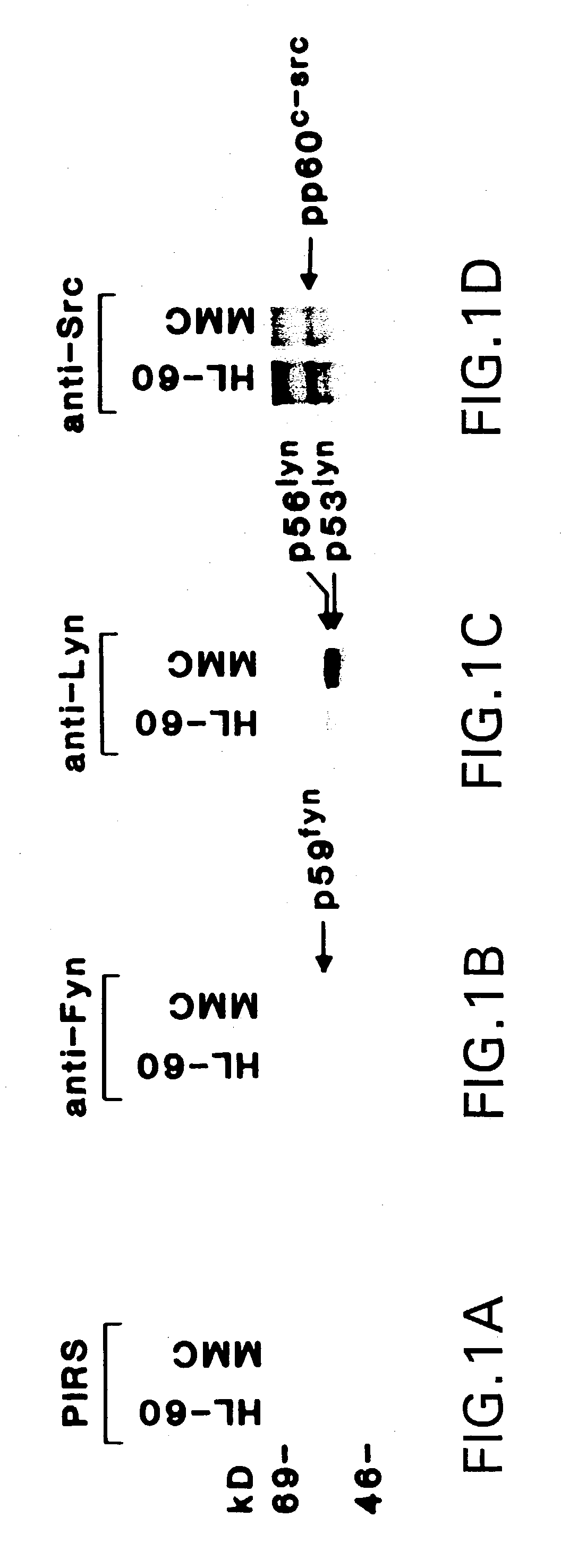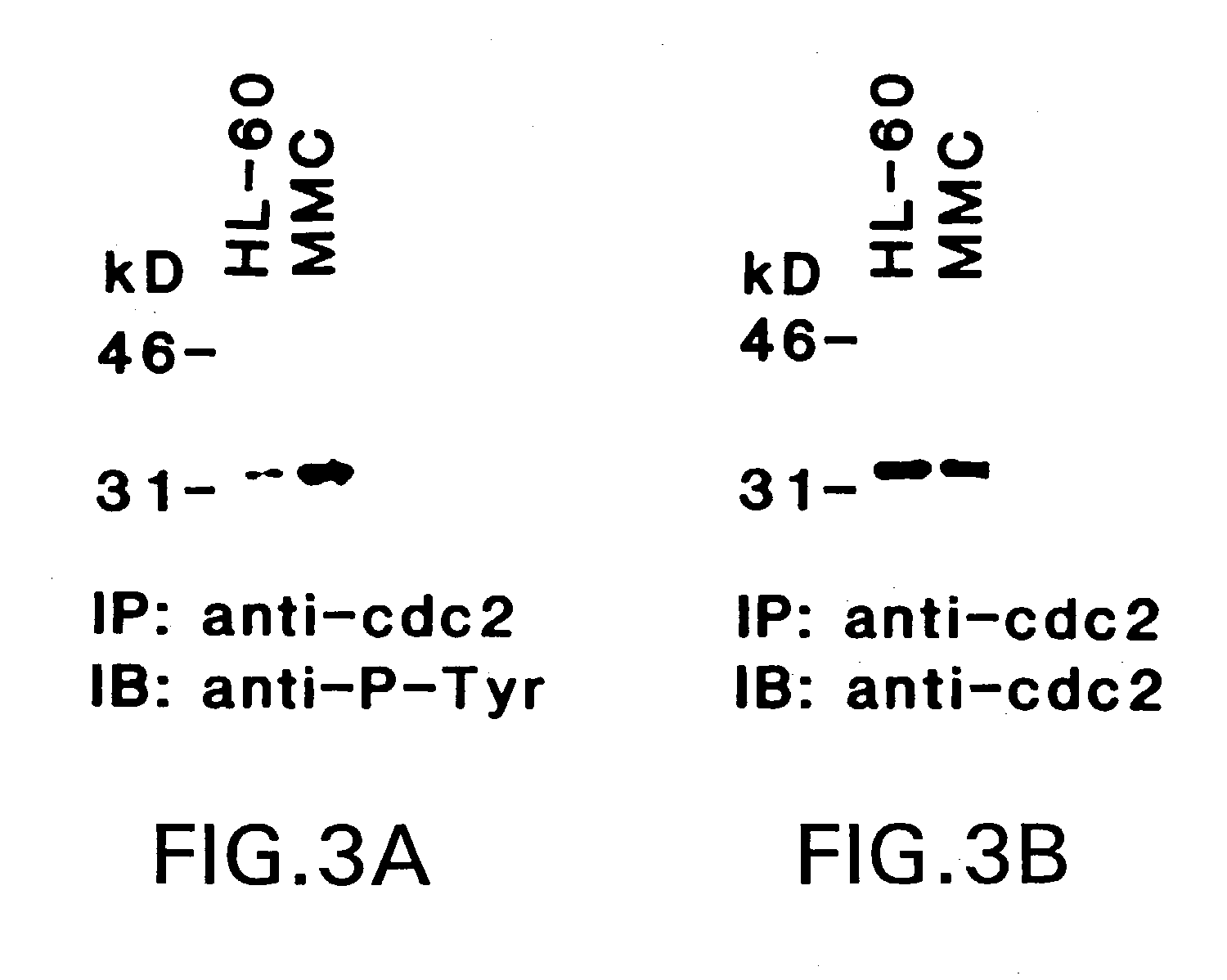DNA damaging agents in combination with tyrosine kinase inhibitors
a technology of tyrosine kinase inhibitor and damaging agent, which is applied in the field of biochemical pathways, can solve the problems of limited effectiveness of current treatment methods for cancer, damage to the dna of the cancer cell, and little information about the effect of this agent on other cells, so as to improve the effect of chemotherapeutic intervention and reduce tumor burden
- Summary
- Abstract
- Description
- Claims
- Application Information
AI Technical Summary
Benefits of technology
Problems solved by technology
Method used
Image
Examples
example i
Alkylating Agents Activate the Lyn Tyrosine Kinase and Promote Tyrosine Phosphorylation of p34cdc2
A. Materials and Methods
[0053]Cell culture. HL-60 cells were grown in RPMI-1640 medium containing 15% heat-inactivated fetal bovine serum (FBS) supplemented with 100 units / ml penicillin, 100 mg / ml streptomycin, 2 mM L-glutamine, 1 mM sodium pyruvate and 1 mM non-essential amino acids. Cells were treated with MMC (Sigma Chemical Co., St. Louis, Mo.), adozelesin (Sigma), cis-platinum (Sigma), nitrogen mustard (Sigma), genistein (GIBCO / BRL, Gaithersburg, Md.), herbimycin A (GIBCO / BRL) and H-7 (Seikagaku America Inc., Rockville, Md.). Cell viability was determined by trypan blue exclusion.
[0054]Immune complex kinase assays. Cells (2–3×107) were washed twice with ice cold phosphate buffered saline (PBS) and lysed in 2 ml of lysis buffer (20 mM Tris, pH 7.4, 150 mM NaCl, 1% NP-40, 1 mM sodium vanadate, 1 mM phenylmethylsulfonyl fluoride, 1 mM DTT and 10 mg / ml of leupeptin and aprotinin). Aft...
example ii
Ionizing Radiation Activates the Lyn Tyrosine Kinase and Promotes Tyrosine Phosphorylation of p34cdc2
[0078]Treatment of human HL-60 myeloid leukemia cells with ionizing radiation is associated with activation of the Lyn tyrosine kinase. The lyn gene encodes two forms of this kinase, p56lyn and p56lyn, as a result of alternate splicing (Yamanashi et al., 1987; 1989). Both p56 / p56lyn, but not certain other Src-related kinases, are activated in irradiated HL-60 cells. Activation of p56 / p53lyn represents a signaling pathway distinct from those involved in X-ray-induced early response gene expression.
[0079]HL-60 myeloid leukemia cells were grown in RPMI-1640 medium containing 15% heat-inactivated fetal bovine serum (FBS) supplemented with 100 units / ml penicillin, 100 mg / ml streptomycin, 2 mM L-glutamine, 1 mM sodium pyruvate and 1 mM non-essential amino acids. Cells in logarithmic growth phase were suspended in complete RPMI-1640 medium with 0.5% FBS 18 hours prior to irradiation.
[0080]...
example iii
DNA Damaging Agents
[0102]Following radiation exposure, many single strand breaks are produced in DNA, but these are readily repaired using the opposite strand of DNA as a template. X-ray energy deposition on DNA may lead not only to strand breakage but to base damage. The breakage may result in incorrect rejoining in pre-replication chromosomes in the G1 phase, leading to chromosomal aberrations, or if the radiation is given late in S or G2, chromatid aberrations will result.
[0103]The skilled artisan in directed to “Remington's Pharmaceutical Sciences” 15th Edition, chapter 33, in particular pages 624–652. Some variation in dosage will necessarily occur depending on the condition of the subject being treated. The person responsible for administration will, in any event, determine the appropriate dose for the individual subject. Moreover, for human administration, preparations should meet sterility, pyrogenicity, general safety and purity standards as required by FDA Office of Biolog...
PUM
| Property | Measurement | Unit |
|---|---|---|
| delay time | aaaaa | aaaaa |
| delay time | aaaaa | aaaaa |
| delay time | aaaaa | aaaaa |
Abstract
Description
Claims
Application Information
 Login to View More
Login to View More - R&D
- Intellectual Property
- Life Sciences
- Materials
- Tech Scout
- Unparalleled Data Quality
- Higher Quality Content
- 60% Fewer Hallucinations
Browse by: Latest US Patents, China's latest patents, Technical Efficacy Thesaurus, Application Domain, Technology Topic, Popular Technical Reports.
© 2025 PatSnap. All rights reserved.Legal|Privacy policy|Modern Slavery Act Transparency Statement|Sitemap|About US| Contact US: help@patsnap.com



